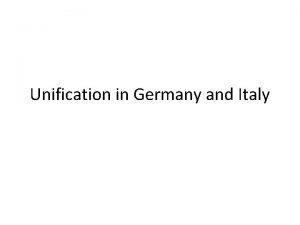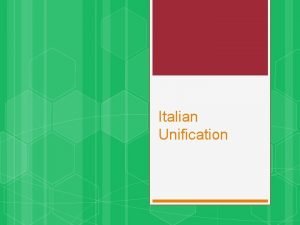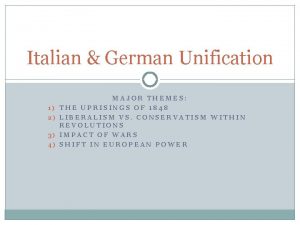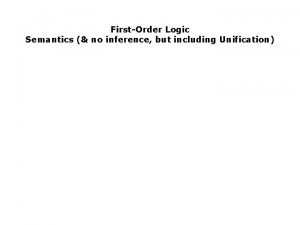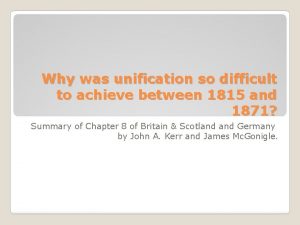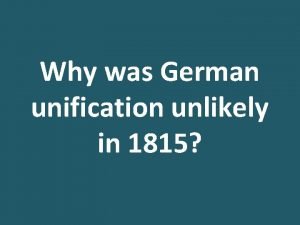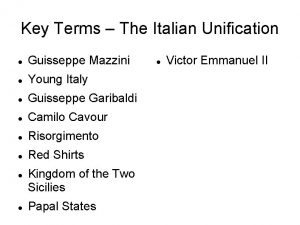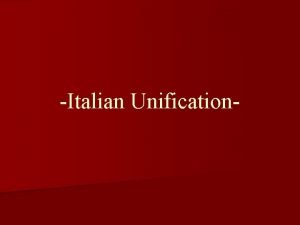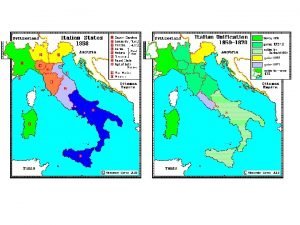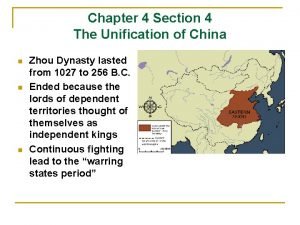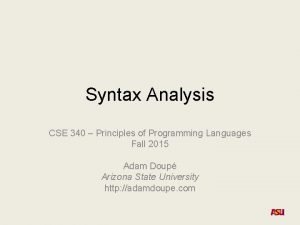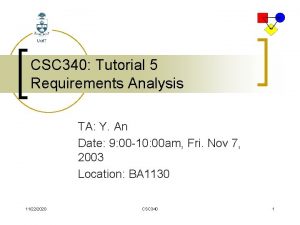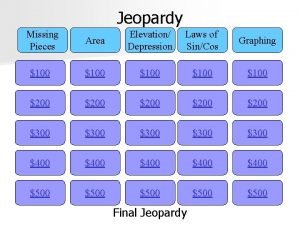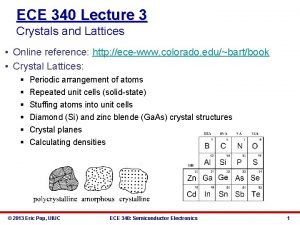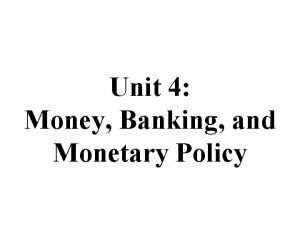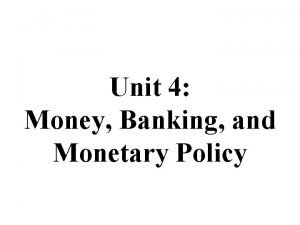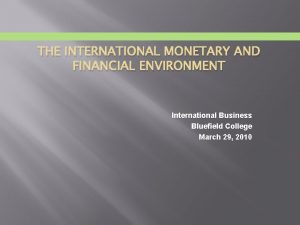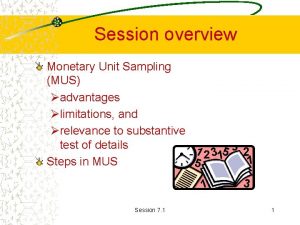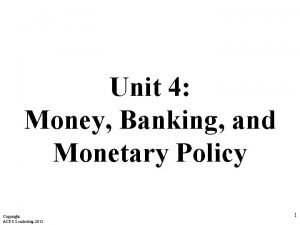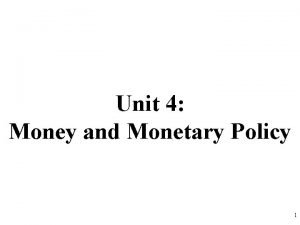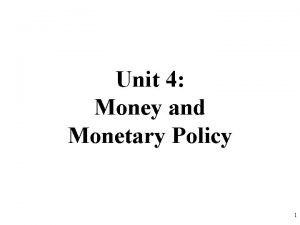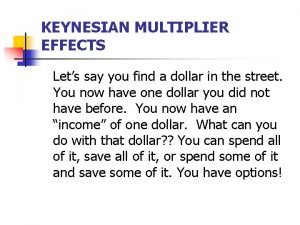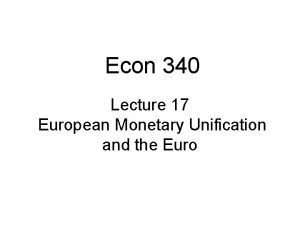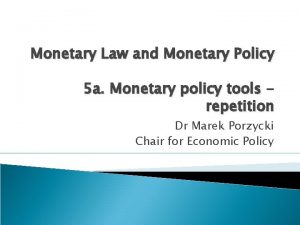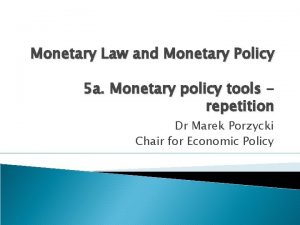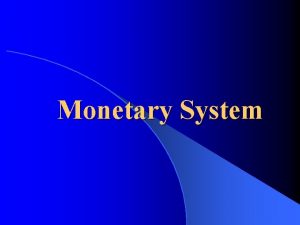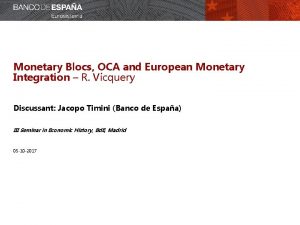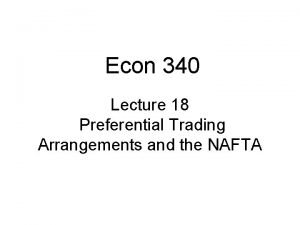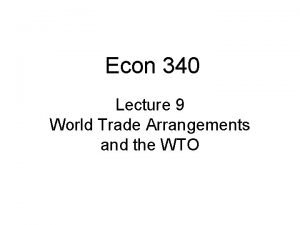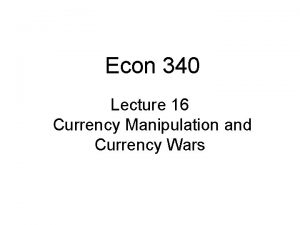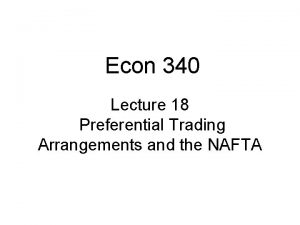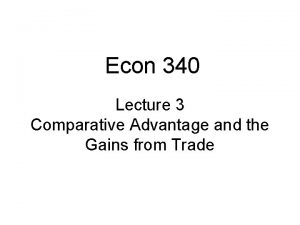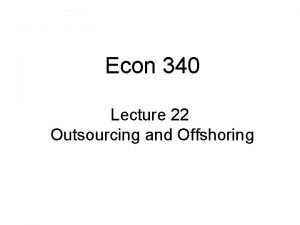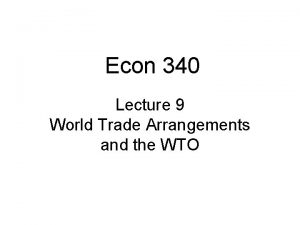Econ 340 Lecture 17 European Monetary Unification and





































































- Slides: 69

Econ 340 Lecture 17 European Monetary Unification and the Euro

Econ 340, Deardorff, Lecture 16: Cur. War 2

Econ 340, Deardorff, Lecture 16: Cur. War 3

Outline: European Monetary Unification and the Euro • • What Is It? History of the EMU Need for Convergence Pros and Cons of Unification – Why Adjustment Is Hard – Winners and Losers under EMU • What Happened? • The Eurozone Crisis Econ 340, Deardorff, Lecture 17: Euro 4

What Is It? • The move to a common currency for a group of countries of Europe – Originally 12 countries – Now 19, with addition of Lithuania Jan 1 2015 • Purpose: To further the economic integration of Europe that – Began with the European Economic Community (a customs union – see next time) – And is today called the European Union (EU) Econ 340, Deardorff, Lecture 17: Euro 5

Euro Zone Members Austria Belgium Cyprus Estonia Finland France Germany Greece Ireland Italy Latvia Lithuania Luxembourg Malta Netherlands Portugal Slovakia Slovenia Spain Econ 340, Deardorff, Lecture 17: Euro 6

Clicker Question Which of the following countries does use the euro? a) ✓ b) c) d) e) Poland Slovenia Sweden Switzerland United Kingdom

Clicker Question Which of the following countries does not use the euro? a) ✓ b) c) d) e) Cyprus Denmark France Greece Lithuania

What Is It? • The currency is shared by all 19 countries and is not controlled by any one of them • It is controlled by the European Central Bank (ECB), based in Frankfurt, Germany • The group of countries is called the Economic and Monetary Union (EMU) (Also, informally, the Eurozone) Econ 340, Deardorff, Lecture 17: Euro 9

Outline: European Monetary Unification and the Euro • • What Is It? History of the EMU Need for Convergence Pros and Cons of Unification – Why Adjustment Is Hard – Winners and Losers under EMU • What Happened? • The Eurozone Crisis Econ 340, Deardorff, Lecture 17: Euro 10

History of the EMU • Before 1973: – All these currencies were pegged to the US dollar • After 1973: – The Bretton-Woods system collapsed and major currencies stopped pegging to US$ – By default, currencies began to float – Europe, because of its large internal trade, found exchange rate movements especially troublesome Econ 340, Deardorff, Lecture 17: Euro 11

History of the EMU • After 1973: – Europe tried several arrangements to get greater stability • Wide-band peg to $ with narrower peg to each other: “Snake in the tunnel” E Snake Tunnel Econ 340, Deardorff, Lecture 17: Euro time 12

History of the EMU • After 1973: – Europe tried several arrangements to get greater stability • Narrow peg to each other with no peg to $: “Floating snake” E Econ 340, Deardorff, Lecture 17: Euro time 13

History of the EMU • 1979 – European Monetary System (EMS) established – Features: Much like Bretton Woods • An Exchange Rate Mechanism (ERM) of exchange rates pegged to each other within ± 2. 25% bands • Provision for adjusting the pegs when needed • A basket of currencies forming the European Currency Unit (ECU) that floated with respect to outside currencies • Capital controls – Did it work? • Inflation rates differed, but their differentials gradually fell • There were 11 currency realignments during 1979 -87 Econ 340, Deardorff, Lecture 17: Euro 14

History of the EMU • 1989: First official statement of the goal of moving toward a common currency • 1991, December: Maastricht Treaty – Agreement on greater unification of member countries, forming the “European Union” – Also included the terms for adopting the common currency Econ 340, Deardorff, Lecture 17: Euro 15

History of the EMU • 1992: Crisis – Denmark voted NO to the Maastricht Treaty – Speculative attacks on currencies forced some to drop out of ERM • 1993: – ERM widened bands to ± 15% – Prospects for EMU looked bleak – Denmark ratified Treaty but “opted out” of the euro; UK also opted out – Germany was last country to ratify Maastricht Treaty Econ 340, Deardorff, Lecture 17: Euro 16

Outline: European Monetary Unification and the Euro • • What Is It? History of the EMU Need for Convergence Pros and Cons of Unification – Why Adjustment Is Hard – Winners and Losers under EMU • What Happened? • The Eurozone Crisis Econ 340, Deardorff, Lecture 17: Euro 17

Need for Convergence • Difficulties of adopting common currency – If countries have different rates of inflation • High-inflation countries will lose markets to low-inflation countries • Exchange rates won’t adjust (a la PPP) to correct for differences – If countries have different interest rates • Capital will flow to high-interest rate countries seeking higher return • Uncertainty about exchange rate won’t offset this – Temptation to run budget deficits when able to borrow from other countries Econ 340, Deardorff, Lecture 17: Euro 18

Need for Convergence • Difficulties of adopting common currency – These suggest that success with a common currency requires countries to have similar • • Inflation rates Interest rates Budget deficits Government debts – Achieving this was called “convergence” and was required in the Maastricht Treaty before a country could adopt the euro Econ 340, Deardorff, Lecture 17: Euro 19

Need for Convergence • Maastricht Convergence Criteria 1. 2. 3. 4. 5. National currency in ERM for 2 years Budget deficit < 3% of GDP Government debt < 60% of GDP Inflation < 1. 5% above average of lowest 3 Long-term interest rates < 2% above average of lowest 3 • How well were they doing? – Following graphs from 1998 article Econ 340, Deardorff, Lecture 17: Euro 20

Econ 340, Deardorff, Lecture 17: Euro 21

Econ 340, Deardorff, Lecture 17: Euro 22

- 1997 Econ 340, Deardorff, Lecture 17: Euro 23

- 1997 Econ 340, Deardorff, Lecture 17: Euro 24

Maintaining Convergence • Stability and Growth Pact (SGP) – Agreed in 1996 that members of the Eurozone would • • Keep their budget deficits below 3% of GDP Pay fines if they broke this limit As we’ll see later, this has been a problem! Econ 340, Deardorff, Lecture 17: Euro 25

Timetable • May 1998: Membership was set – Based on convergence – All of then 15 EU members, except • UK, Denmark, Sweden – who opted out • Greece – who failed to converge (Greece did enter soon after) • Jan 1, 1999: Euro was launched (except notes/coins) – – – Value of euro = 1 ECU as of midnight Dec 31, 1998 = $1. 18 Currencies “irrevocably” linked Single monetary policy: ECB (European Central Bank) New public debt issued in euros Financial markets started using euro • Jan 1, 2002: Notes/coins started circulating • Jul 1, 2002: National notes/coins retired Econ 340, Deardorff, Lecture 17: Euro 26

Econ 340, Deardorff, Lecture 17: Euro 27

The euro notes and coins • Note what does not appear: – People – Actual buildings and places • Purpose was to treat all members equally • Result was that the currency lacks personality • People don’t much like it, and they miss their old national currencies. • See Kulish Econ 340, Deardorff, Lecture 17: Euro 28

Members ia an Fi ce nla Lu nd xe Ita mb ly ou rg Ne th er Ge lan rm ds an y Po rtu Ire ga lan l Gr d ee Sp ce ain Fr str Au Be lgi u m • As of 2002, EU had 15 members, of whom 12 adopted the euro BAFFLING PIGS Econ 340, Deardorff, Lecture 17: Euro 29

Members De nm ar k Un i Ki ted ng do Sw m ed en • And 3 did not DUKS Econ 340, Deardorff, Lecture 17: Euro 30

Members • Since 2002, the Eurozone has become: BAFFLING PIGS + SCLELMS? 9) 00 (2 ia ak 8) 5) ov 00 1 Sl (2 00 ta (2 ) al a M ni 11 ua 0 th (2 Li nia 14) to 20 8) Es ia ( 00 ) tv (2 07 La us 20 pr ia ( Cy en ov Sl 31 Econ 340, Deardorff, Lecture 17: Euro

Clicker Question Which of the following was not one of the Maastricht Convergence Criteria? a) b) c) ✓ d) e) Budget deficit < 3% of GDP Government debt < 60% of GDP Inflation < 1. 5% above average of lowest 3 Growth rate of per capita GDP above 1% Long-term interest rates < 2% above average of lowest 3

Clicker Question Which of the following was one of the Baffling Pigs, but as of 1997 had both budget deficit and public debt above the maxima specified in the Maastricht Convergence Criteria? a) b) ✓ c) d) e) Denmark Finland Greece Italy United Kingdom

Clicker Question Whose face appears on the € 100 note? a) b) c) d) ✓ e) Charles de Gaulle Benito Mussolini Benjamin Franklin Winston Churchill Nobody

Outline: European Monetary Unification and the Euro • • What Is It? History of the EMU Need for Convergence Pros and Cons of Unification – Why Adjustment Is Hard – Winners and Losers under EMU • What Happened? • The Eurozone Crisis Econ 340, Deardorff, Lecture 17: Euro 35

Pros and Cons of Unification • Proponents expected – – – – Complete the internal market Improved competition & efficiency Arbitrage across national borders New era of prosperity Stable prices Fiscal discipline Lower interest rates Ø thus higher investment Ø Stronger growth – More jobs Econ 340, Deardorff, Lecture 17: Euro 36

Pros and Cons of Unification • Opponents expected – Division of the EU (baffling pigs vs. duks) – Loss of sovereignty – Little popular support – Regulatory & other costs – Difficulties of adjustment to asymmetric shocks (As had happened before, e. g. , with German unification and discovery of North Sea Oil) Econ 340, Deardorff, Lecture 17: Euro 37

Outline: European Monetary Unification and the Euro • • What Is It? History of the EMU Need for Convergence Pros and Cons of Unification – Why Adjustment Is Hard – Winners and Losers under EMU • What Happened? • The Eurozone Crisis Econ 340, Deardorff, Lecture 17: Euro 38

Pros and Cons of Unification • Why adjustment is hard – Like states in the US, countries in Eurozone have • No exchange-rate tool • No separate monetary policies • Very limited fiscal policies (due to SGP) – Unlike US states, however, in Eurozone • Labor is less mobile across countries • Wages are less flexible, due to social policies • No mechanism for fiscal transfers among countries Econ 340, Deardorff, Lecture 17: Euro 39

Pros and Cons of Unification • Without adjustment – When one country is hit with a shock that others are not (i. e. , an “asymmetric shock”), • • Its markets don’t adjust (rigid wages) Its people don’t move It has fewer policies to deal with this Other countries don’t help Econ 340, Deardorff, Lecture 17: Euro 40

Outline: European Monetary Unification and the Euro • • What Is It? History of the EMU Need for Convergence Pros and Cons of Unification – Why Adjustment Is Hard – Winners and Losers under EMU • What Happened? • The Eurozone Crisis Econ 340, Deardorff, Lecture 17: Euro 41

Winners and Losers from EMU • Winners – Multinational companies: their costs of operating in multiple countries were reduced – Europe’s biggest banks were expected to gain, through consolidation across borders – Consumers, able to comparison-shop across borders • Losers – Small firms (e. g. shops, restaurants), for whom changeover was costly, with little benefit Econ 340, Deardorff, Lecture 17: Euro 42

Clicker Question Which of the following is not a reason why adjustment in the euro zone is difficult? a) No mechanism for fiscal transfers b) Countries cannot individually depreciate their currencies c) Countries are constrained from using fiscal expansion d) Labor market policies impede wage adjustment ✓ e) Labor is too mobile among countries

Outline: European Monetary Unification and the Euro • • What Is It? History of the EMU Need for Convergence Pros and Cons of Unification – Why Adjustment Is Hard – Winners and Losers under EMU • What Happened? • The Eurozone Crisis Econ 340, Deardorff, Lecture 17: Euro 44

What Happened? • Euro started (Jan 1, 1999) at 1. 18 $/€ • Now (Nov 6, 2019) it is 1. 11 $/€ • So euro has simply fallen, right? • Hardly! It’s not that simple. Econ 340, Deardorff, Lecture 17: Euro 45

From IMF, International Financial Statistics 1999 Jan 1999 Nov 2000 Sep 2001 Jul 2002 May 2003 Mar 2004 Jan 2004 Nov 2005 Sep 2006 Jul 2007 May 2008 Mar 2009 Jan 2009 Nov 2010 Sep 2011 Jul 2012 May 2013 Mar 2014 Jan 2014 Nov 2015 Sep 2016 Jul 2017 May 2018 Mar 2019 Jan What Happened since 1999? US $ per € 1, 800 1, 600 1, 400 1, 200 1, 000 “Parity” 0, 800 0, 600 0, 400 0, 200 0, 000 Econ 340, Deardorff, Lecture 17: Euro 46

What Happened over the Last Year? US $ per € 5. 5% From X-Rates. com Econ 340, Deardorff, Lecture 17: Euro 47

What Happened over the Last Month? US $ per € 2. 1% From X-Rates. com Econ 340, Deardorff, Lecture 17: Euro 48

What Happened? • Euro fell, after its creation by about 25% to 2001 • Then it rose by 2004 back to slightly above where it started • By 2008 it had risen to over $1. 50, only to fall in 2009 • From 2004 to 2014, it stayed at or above $1. 20 • It then fell to about $1. 10, then $1. 05 where it stayed until early 2017. • Some thought it would go below “parity” of $1. 00, but instead it rose to over $1. 20 and is now back down to $1. 11 Econ 340, Deardorff, Lecture 17: Euro 49

What Happened? • Why all this change? I don’t think we know, for the changes that happened over most of this period. • The fall since 2014 – from over $1. 30 in 2013 to about $1. 05 two years ago – was due to – Weakness of the Eurozone economies – The ECB’s use of “Quantitative Easing” to lower interest rates and stimulate the economy – The US Fed’s interest rate increase and signals that it would raise them further • Why did it rise, then fall, over the last two years? Some would say because of Trump Econ 340, Deardorff, Lecture 17: Euro 50

What Happened? • Has the euro worked well for Europe? – There were problems, even in the early years • Many in Europe perceived that prices rose when converted to euros • Several countries broke the limit of the SGP – Portugal: suffered criticism but was not fined – France, Germany » Too big even to criticize » Instead EU revised the SGP – In the last decade, the PIGS (Portugal, Ireland, Greece, & Spain) » Or PIIGS, including Italy Econ 340, Deardorff, Lecture 17: Euro 51

What Happened? • Has the euro mattered for the US? – Not much – When the euro fell initially, it made it hard for US to compete – In 2007 -8, with euro’s rise, • US benefited as sellers • US was hurt as consumers and as tourists Econ 340, Deardorff, Lecture 17: Euro 52

What Happened? • Has the euro mattered for the US? – There used to be talk of central banks switching from dollars to euros as reserves • So far, little sign that this is happening Econ 340, Deardorff, Lecture 17: Euro 53

Clicker Question When did the exchange-market value of the euro reach its lowest against the dollar? a) ✓ b) c) d) e) 1999 2000 2008 2015 2018

Clicker Question Which of the following countries are members of the Eurozone who have been fined for violating the Stability and Growth Pact? a) b) c) d) ✓ e) France Germany Greece All of the above None of the above

Outline: European Monetary Unification and the Euro • • What Is It? History of the EMU Need for Convergence Pros and Cons of Unification – Why Adjustment Is Hard – Winners and Losers under EMU • What Happened? • The Eurozone Crisis Econ 340, Deardorff, Lecture 17: Euro 56

The Eurozone Crisis • The crisis consisted of (see Baldwin et al. ) – News of Greek debt, and concerns about Greece’s ability to manage it – Increased interest rates in Greece and other Eurozone countries, threatening debt problems there as well – Bailouts by EU, ECB, and IMF (the “Troika”) – Concern that the Eurozone might break up – Commitment by ECB’s Draghi to “Do whatever it takes” to save the eurozone. Econ 340, Deardorff, Lecture 17: Euro 57

The Eurozone Crisis: Timing Source: Baldwin et al. , “Rebooting the Eurozone” Econ 340, Deardorff, Lecture 17: Euro 58

The Eurozone Crisis: Timing Source: Baldwin et al. , “Rebooting the Eurozone” Econ 340, Deardorff, Lecture 17: Euro 59

The Eurozone Crisis: Timing Source: Baldwin et al. , “Rebooting the Eurozone” Econ 340, Deardorff, Lecture 17: Euro Note that Greece was not solved, and crisis may not be over. 60

What Happened? • The problem of Eurozone imbalances – The common currency fostered current-account imbalances – Surplus countries lent to deficit countries – Without institutions (banking union, fiscal union) to assist adjustment, loss of confidence could cause “sudden stop” of creditors’ willingness to lend – That set the stage for crisis. Econ 340, Deardorff, Lecture 17: Euro 61

The Eurozone Crisis: Timing Peripheral EZ Members Core EZ Members Source: Baldwin et al. , “Rebooting the Eurozone” Econ 340, Deardorff, Lecture 17: Euro 62

What Happened? • The problem of Greece (started in 2010) – Greek government deficits had been over 10% of GDP • (compare SGP limit of 3%) – Greek debt rose to about 160% of GDP • (compare SGP limit of 60%) – Markets feared default; speculators attacked both Greek bonds & euro – EU (esp Germany) were reluctant to help (& was prohibited by Lisbon Treaty) – Greek austerity caused massive protests Econ 340, Deardorff, Lecture 17: Euro 63

What Happened? • The Euro Zone today – In process of negotiating a mechanism to • Provide loans to member countries in trouble • Put pressure on them for austerity: – Cut spending – Raise taxes • Form “banking union” to safely manage bank failures – These mechanisms are still not in place Econ 340, Deardorff, Lecture 17: Euro 64

What Happened? • The Euro Zone today – Still trying to solve the problem of Greek debt – Tradeoff between – Bailout money from others to pay it off » Favored by weaker EU countries (e. g. , France) – Cutting value of bonds to private sector holders » Called “haircut” (also “bail-in”) » Also called “Private-sector involvement” (PSI) » Favored by stronger EU countries (e. g. , Germany) Econ 340, Deardorff, Lecture 17: Euro 65

What Happened? • The Euro Zone today – Fear that if not solved, • Greece would default • Speculators would attack other weak countries’ bonds • Greece and others will be forced to leave the euro – These concerns seemed to have abated in 2014, but then Greece elected a government opposed to the terms of the bailout. – Greece is still struggling, now under another new government, and fears of crisis in the Eurozone have lessoned but not disappeared Econ 340, Deardorff, Lecture 17: Euro 66

What Happened? • The Euro Zone today, per the Smaghi reading – Crises are caused by • “Doom loop” where banks hold government debt, and doubts about the latter cause bank runs • “Perverse loop” (Smaghi’s term) where fear of exit from the euro causes capital outflow that makes exit more likely – Smaghi recommends a formal procedure for exiting the euro, and that it be combined with exiting the EU • That, he says, would discourage those who want to exit the euro Econ 340, Deardorff, Lecture 17: Euro 67

Clicker Question What happened to settle the markets during the Eurozone Crisis? a) Rich countries agreed to bail out the poor countries b) The euro was allowed to float on the exchange markets c) The United States made large payments into the European Stability Fund ✓ d) The ECB President promised to do whatever it takes to save the euro e) Greece stopped using the euro and returned to the drachma

Next Time (after exam) • Preferential Trading Arrangements and the NAFTA – What are they? – Their effects – NAFTA – Other Econ 340, Deardorff, Lecture 17: Euro 69
 German and italian unification compare and contrast
German and italian unification compare and contrast 01:640:244 lecture notes - lecture 15: plat, idah, farad
01:640:244 lecture notes - lecture 15: plat, idah, farad Chapter 23 lesson 3 nationalism unification and reform
Chapter 23 lesson 3 nationalism unification and reform National unification and the national state
National unification and the national state Prolog langage
Prolog langage Italian unification summary
Italian unification summary Sardina
Sardina Zollverein germany map
Zollverein germany map Strong devotion
Strong devotion St an
St an Unification operating model
Unification operating model First order logic unification
First order logic unification Germany before unification
Germany before unification Why was italian unification difficult to achieve
Why was italian unification difficult to achieve Unification of china
Unification of china Prolog unification
Prolog unification Obstacles to german unification
Obstacles to german unification Unification algorithm example
Unification algorithm example Germany before 1871
Germany before 1871 Gauge coupling unification
Gauge coupling unification Obstacles to italian unification
Obstacles to italian unification Unification of italy class 10
Unification of italy class 10 Italian risorgimento timeline
Italian risorgimento timeline Stages of german unification
Stages of german unification The unification of china
The unification of china Oba-340
Oba-340 Viksund 340 st cruz
Viksund 340 st cruz 2,340,000,000
2,340,000,000 Números enteros
Números enteros Mgt 340 report
Mgt 340 report Ece 340
Ece 340 Artigo 330 cp
Artigo 330 cp Szkoła podstawowa nr 340 warszawa
Szkoła podstawowa nr 340 warszawa Cse 340 asu
Cse 340 asu Cse 340 principles of programming languages
Cse 340 principles of programming languages Ece 340
Ece 340 Ece 340 uiuc
Ece 340 uiuc Cse 340 asu
Cse 340 asu System design tutorial
System design tutorial Csc 340
Csc 340 Oba-340
Oba-340 Oba-340
Oba-340 Cse 340 principles of programming languages
Cse 340 principles of programming languages 124 ucas points
124 ucas points Adam doupe cse 340
Adam doupe cse 340 3253/340
3253/340 Adam doupe cse 340
Adam doupe cse 340 Csc 340
Csc 340 To be born
To be born Rounding number rules
Rounding number rules From a point 340 from the base of hoover dam
From a point 340 from the base of hoover dam Illbruck pr007
Illbruck pr007 Codigo 340
Codigo 340 Uiuc ece 340
Uiuc ece 340 Ece 340
Ece 340 Uninstalled materials asc 606
Uninstalled materials asc 606 Ece 340 uiuc
Ece 340 uiuc Byu cs 340
Byu cs 340 Unit 4 money banking and monetary policy
Unit 4 money banking and monetary policy Unit 4 money banking and monetary policy
Unit 4 money banking and monetary policy Contractionary monetary policy
Contractionary monetary policy International monetary and financial environment
International monetary and financial environment International financial environment
International financial environment Monetary unit sample
Monetary unit sample Unit 4 money and monetary policy
Unit 4 money and monetary policy Unit 4 money and monetary policy
Unit 4 money and monetary policy Unit 4 money and monetary policy
Unit 4 money and monetary policy Mpc in economics formula
Mpc in economics formula Econ crowding out
Econ crowding out Flip it econ
Flip it econ
